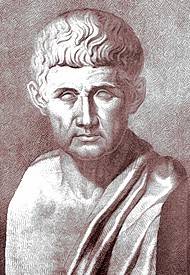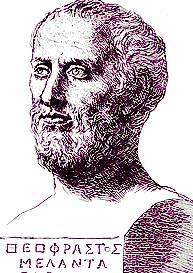During early human culture, plants seem to have been looked at only from the point of view of utility and medicinal use. But in the following they were, too, studied to get to know them and their way of function better. They were compared to animals and man and their interconections started to be noticed.
EMPEDOCLES from Agrient (Akragas) is the best known representative of the Pythagorean philosophical school. In his view, the world was composed out of the four elements water, fire, earth and air. As elements, they are eternal and immortal and both the formation and the decline of the bodies can be explained by their reciprocal attraction and repulsion. He taught that plants, just like animals, had not only a soul that could be longing or saddened, but that they, too, had reason and common sense. The branches and leaves, that are directed towards the sun and soon regain this direction after having been bent down, seemed to confirm his view. EMPEDOCLES thought that plants came into being earlier than animals and that their organism formed no integrated whole, but that every part lived on its own.
 Few
is known about ARISTOTLE's work on plants [384 BC (Stagira) - 322
BC (Chalkis)], but his extensive work on the animal kingdom had formative
influence on the perception of following centuries. Many of his preserved
works contain references to the nature of plants. He noticed, that classification
of nature was possible and that a continuous transition from inanimate
to living animals existed. In his view, plants ranked in the middle between
inanimate and animals and he believed in the existence of transitions from
plants to animals. Thus, he was not sure about the assignment of some marine
creatures to one or the other group.
Few
is known about ARISTOTLE's work on plants [384 BC (Stagira) - 322
BC (Chalkis)], but his extensive work on the animal kingdom had formative
influence on the perception of following centuries. Many of his preserved
works contain references to the nature of plants. He noticed, that classification
of nature was possible and that a continuous transition from inanimate
to living animals existed. In his view, plants ranked in the middle between
inanimate and animals and he believed in the existence of transitions from
plants to animals. Thus, he was not sure about the assignment of some marine
creatures to one or the other group.
Till after the renaissance the word "soul" recurred often in this context and would today probably be replaced by "life" instead. Which gives a new expression to an old question: What is life? Why do plants belong to the living and how do they differ from the inanimate?
Many answers to these questions have been given. ARISTOTLE ascribes the living the ability to think and to feel, to move and to grow. He was aware of the connection of ingestion (with plants through the roots) and growth. In contrast to animals, ARISTOTLE found the female in plants to be undivided from the male, plants seemed to bear both genders. For him the main purpose of vegetation was the production of fruit and propagation.
 The
most important and influential botanist of antiquity was THEOPHRASTUS (371-286
BC), a pupil of ARISTOTLE. He inherited both his teacher«s library
and unpublished works and continued to work on them. He spent, just like
his teacher, the decisive years of his life in Athens, where he gathered a lot
of pupils and was in charge of the first existing botanical garden, of
whose size, different plant species and time of existence nothing came
down on us. THEOPHRASTUS is the author of two remaining works:
The
most important and influential botanist of antiquity was THEOPHRASTUS (371-286
BC), a pupil of ARISTOTLE. He inherited both his teacher«s library
and unpublished works and continued to work on them. He spent, just like
his teacher, the decisive years of his life in Athens, where he gathered a lot
of pupils and was in charge of the first existing botanical garden, of
whose size, different plant species and time of existence nothing came
down on us. THEOPHRASTUS is the author of two remaining works:
- De historia plantarum (A History of Plants)
and- De causis plantarum (About the Reasons of Vegetable Growth)
Both works became known to the occidental culture during the middle of the 15th century, when Pope NICHOLAS V ordered the Greek T. GAZA to translate them into Latin (published 1483 in Treviso). The translation is said to be poor, but the manuscripts are lost. In 1497, a new version, that contained partly more and partly less mistakes than the preceding one, was published. The first German translation was done by K. SPRENGEL in 1822. For a long period of time, THEOPHRASTUS' work was the indespensable guideline for all understanding and teaching of botany. Both works are of a general nature, plant species are only mentioned casually and it is often hard to find out, which species are actually meant. THEOPHRASTUS« knowledge of foreign species was sketchy, although he reported on them, too. At that time the Greeks knew, due to the campaigns of ALEXANDER THE GREAT, of India, Persia, Bactria, Syria, Egypt and Lybia. But the travel stories of ALEXANDER's companions were mostly unreliable and often contradictory.
THEOPHRASTUS' books are summarized briefly in the following since they had a large influence, if only to show how varied the knowledge of plants was in antiquity and what criteria were used to order the findings. Misinterpretations, wrong generalizations and errors based on inaccurate copies or translations will largely be omitted.
consists of nine books:
1.: The anatomy of plants: flowers, catkins, leaves, fruit, sap, fibres,and heartwood
Trunks: great differences concerning heights and strength, composition, layering and the flake of the bark
Inner structures: woody or fleshy, knots,and thorns
Roots: nummerous as in cereals or single taproots, deep roots or superficial ones, differing in smoothness and strength, with frequent or rare rooting; in the case of many garden plants thickened as turnips; airy roots (as with Indian fig tree)
Leaves: great diversification concerning shape, direction, position and composition
Seeds: need humidity and warmth, otherwise no germination; directly beneath the outer shell, individually or numerous. Sometimes enclosed by flesh or shells, sometimes in a capsule or a skin (wheat, millet) or in an ovary capsule as in poppy.
Flowers: small and simple (wine, mulberry tree) or leafy; sometimes unicoloured petals, sometimes differnt colors for petals and sepals; blossoms are mostly simple and whitish, with the exception of the pomegranate tree and some varieties of almond trees; some flowers are sterile.
Trees and plants grow in general out of seeds, roots, runners, branches, sprigs and some even out of the trunk, if sawn into discs. THEOPHRASTUS remarks that cultured trees generally impair when grown out of seeds and that they tend to align with the wild types, while wild typ trees do not change and thus conserve their species. The ability to germinate decreases with the age of the seeds. In general it is gone within their fourth year, though peas and beans keep it longer. Insects support the ripening of fruits and habitat and climate have an impact on plant growth. Cultured plants are often infested with diseases, while this hardly ever occurs to wild plants. This depiction is followed by a systematology of plants. THEOPHRASTUS groups them in trees, shrubs, herbaceous perennial plants and herbs.
2.-5.: Wooden plants
2. "Tame" plants and their cultivation
3. Wild plants
4. Foreign trees and shrubs, their lifespan and diseases
5. Characteristics of wood and how to treat it. Natural ways of reproduction and propagation. Artificial insemination of a female palm with the inflorescence of a male plant. Propagation of seeds (by way of rainfall, flooding and birds)6. Herbaceous perennial plants: Wild ones, where differences are made between those with and without thorns, and "tame" ones (among them ornamental plants)
7. Vegetables and their cultivation: wild plants; plants of the field that are used as vegetables; herbs
8. Cereals: standing grain and peas and beans (the latter being counted as cereals)
9. Saps and medicine:
This work consists of six books:
1.: An overall view of the different ways of coming into being; propagation and growth of plants. Plants develope out of seeds, by themselves or out of parts of another plant. Some plants use only one of the mentioned ways, while others use some of them. Grafting and budding.
The ripening of the fruit«s involucre has to be distinguished from that of the fruit itself and from that of the seed. The first make the plant desirable as foodstuff, the latter are important for the preservation of the species, which makes them conflicting processes.
2.: About the changes in environment by forces of nature, that plants, especially trees, have to suffer:
- meteorology and geology
- trees growing in dense woods without sun or wind become weak
- the influence of one plant on another: benefits and damage caused by nearby plants
- movement of leaves, flowers etc at certain times of the year or the day
3.: About the changes caused by culture that plants have to cope with. Tree plantations: choice of a suitable soil, space between single trees. Trimming of the roots after watering, choice of the fertilizer; rhythm of fertilizing; breaking up of the soil, weeding. Plants growing too close have a negative impact on each other due to the arising shortage of nutriments. But plants may, too, be cultivated between grapevine to get rid of too much soil humidity. Cereals: diseases, rust of wheat, barley, peas and beans. Importance of sowing in due time.
4.: Origin and propagation of cereals
5.: Artifical and unnatural influences; disease and death
6.: About the odour and the taste of plants
|
|